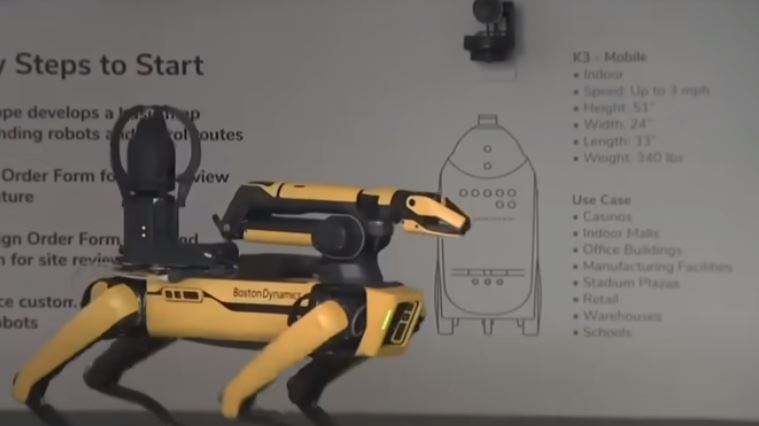NYPD deploys robot cop to Times Square subway station
09/29/2023 / By Zoey Sky

Knightscope 5 (K-5), a police robot manufactured by Knightscope, is now patrolling New York City’s busiest subway station in a new pilot program.
At a news conference announcing the deployment of the robot, NYC Mayor Eric Adams said the city must “use every available method.”
Adams said NYC is leasing the K-5 robot for $9 an hour, which is below the minimum wage in the city. The mayor said the robot is cost-effective, adding that K-5 doesn’t need bathroom breaks or meal breaks.
K-5, which weighs about 420 pounds, will patrol the station from midnight to 5 a.m. during the two-month test.
According to Adams, K-5 is “taking existing technology and putting it on wheels.” He emphasized that while the robot can record video, it will not record audio or use facial recognition technology.
K-5 has a button that can be used to report a crime to a live person, but a New York City Police Department (NYPD) officer will accompany the robot at all times during the trial. (Related: “Digi-Dog” Police ROBOTS set to take over New York City and “POLICE” any protests about Big Government tyranny or the next plandemic.)
City officials hope the robot can operate on its own after the test.
Knightscope said the 5-foot-tall robot can operate indoors or outside and that K-5 has a maximum speed of three miles per hour. The robot can also recharge itself without the need for human assistance.
The American Civil Liberties Union (ACLU) of New York, which has criticized other technology that the NYPD has already started using, including robotic police dogs, warned that the K-5 robot could create privacy issues.
Daniel Schwarz, senior privacy and technology strategist for ACLU of New York, said the move is a boastful one, especially since city agencies have reduced their budgets.
He added that the NYPD is now just using “new and unnecessary surveillance tools.”
Schwarz said New Yorkers must be provided “comprehensive oversight, regulation” and transparency when it comes to new surveillance tools to make sure that personal data isn’t exploited and that communities are safe from harassment, targeting or abuse.
NYPD previously criticized for police dog testing
In 2021, the NYPD drew flak for testing robot “dogs,” which it deployed in several situations, such as to deliver food in a hostage situation and to scout out a location where the police believed a dangerous gunman could be hiding. The Digidogs that the NYPD used in 2021 also evoked primal science-fiction fears.
Behind the uneasiness are several serious issues. The robots seem creepy because everybody implicitly understands that there is a chance law enforcement can weaponize them.
Additionally, there is the worry that the robots could evolve from a remote-controlled tool to an autonomous decision-maker that will be allowed to make actual law enforcement decisions. This then leads to the many issues around bias and inaccuracy in artificial intelligence decision-making.
The worst scenario involves robots that are armed and made autonomous.
There are more immediate concerns about the costs and benefits of these high-tech devices. Anybody can invent a Hollywood scenario where a new technology saves the day.
The real questions are:
- How common are these scenarios?
- How dangerous are they?
- How effective is the solution?
- How expensive is it?
- What negative side effects could its adoption bring?
- Are there alternative, less invasive solutions that would work just as well?
Communities should ask these necessary questions.
While viewed narrowly, it seems perfectly fine to use a robot to scout a dangerous location or deliver food to hostages. However, communities must scrutinize expensive, rare-use technologies at a time when the nation is increasingly recognizing the need to invest in solving social problems in better ways than empowering police.
Full transparency and meaningful limitations are also important. When a powerful new surveillance or other police technology is introduced, like K-5, there must be public conversations every step of the way.
The public must be informed about the answers to questions such as:
- What are the plans and policies around how it will be used?
- How is it actually used?
And none of those conversations can happen without transparency and independent oversight.
Communities can make sure that happens by joining the growing list of cities that have passed “Community Control Over Police Surveillance” (CCOPS) legislation. They require police to be transparent about their use of surveillance technologies and take measures so that community members, through their city council representatives, are allowed to decide if and how such technologies are used.
In 2021, New York City joined the cities that passed that kind of legislation with its Public Oversight of Surveillance Technology (POST) Act. Unfortunately, the information that the NYPD has about Digidog is inadequate.
Instead of publishing detailed policies for the robot dog, the department included the technology in an overbroad category with other camera technologies. The policy isn’t clear about specifics, such as when the technology can be used. The policy has also made false statements about the machine learning and video analytics capabilities of the Digidog.
The deployment of advanced technologies like robots usually happens faster than social, political and legal systems in the country can adjust. Because this kind of robotics technology can easily be abused, clear and forthright policies, overall transparency and democratic debate and input are crucial to ensure public safety and freedom.
Watch the video below for a closer look at K-5.
This video is from the Slappy 27 channel on Brighteon.com.
More related stories:
AI and genetic engineering could trigger a “super-pandemic,” warns AI expert.
Sources include:
Submit a correction >>
Tagged Under:
AI, armed robot, big government, computing, digi-dog, future tech, Glitch, K5, Knightscope 5, national security, New York, New York Police Department, nyc police dog, police robots, police state, privacy watch, robo-dog, robotics, surveillance, Times Square Subway, weapons tech
This article may contain statements that reflect the opinion of the author
RECENT NEWS & ARTICLES
COPYRIGHT © 2017 COMPUTING NEWS



















